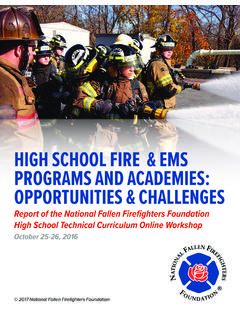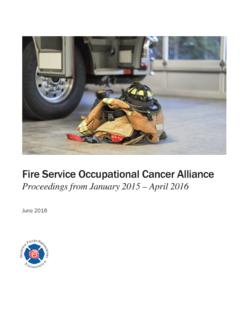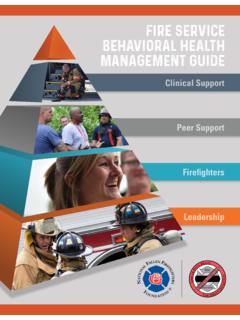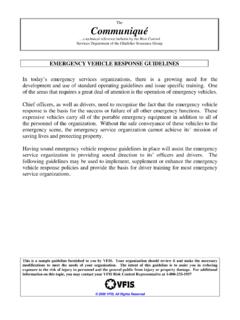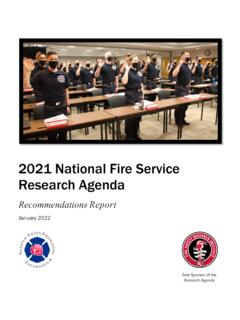Transcription of RADIO COMMUNICATIONS FOR THE FIRE SERVICE - Everyone …
1 RADIO COMMUNICATIONS FOR THE FIRE SERVICE : A Planning Guide for Obtaining the COMMUNICATIONS System You Need for Enhanced Safety and Emergency Preparedness ABOUT THIS GUIDEF irst responders know exactly how their COMMUNICATIONS are supposed to work. Fire departments need acommunications system that's reliable in the dense downtown area, in high-rise buildings with a lot ofconcrete and steel and that operates well in the rural areas with varying terrains. The police department needs a system that functions reliably from portable radios in moving vehicles. A first responder system must accommodate both is a lifeline, and for people who put their lives on the line every day, reliable communication is vitaleverywhere, every time.
2 Today, in the interest of interoperability and cost justification, first responders are being asked to participate in countywide, statewide, countrywide or citywide shared COMMUNICATIONS systems. Although fire departmentsare being asked to be a part of these multi-agency systems, they are often not part of the process of definingthe specifications. This can result in a system that does not meet the unique needs of the fire SERVICE . The range of technologies and alternative solutions available is staggering. Choosing and implementing a newwireless COMMUNICATIONS system can seem a formidable task. To ensure successful outcomes for new COMMUNICATIONS systems, it is necessary to become involved early on in the planning process.
3 You ll discover that some commonly overlooked factors can have a surprisinglyimportant impact on how well your personnel can communicate. The critical areas covered in this guideinclude appropriate levels of funding for system development, project staffing, training, acceptance testing and problem primary responsibility is that Everyone goes home safe at the end of each shift. As fire professionals, we are proud of our profession and strive to give citizens our best effort to save lives and property. One of the most important elements of life safety equipment is reliable, effective RADIO the help of this guide, you will be able to take the first steps in creating informed, thoughtful decisions to facilitate the development of an effective emergency COMMUNICATIONS Killen Fire Chief, international Associationof Fire ChiefsPresidentChief Ronald Jon SiarnickiExecutive Director,National Fallen FirefightersFoundationPhilip C.
4 StittleburgChairman, National Volunteer Fire CouncilWilliam M. WebbExecutive Director,Congressional FireServices InstituteTABLE OF CONTENTSCHAPTER 1:3 IntroductionCHAPTER 2:4 The Fire SERVICE PerspectiveCHAPTER 3:9 The COMMUNICATIONS Planning TeamCHAPTER 4:12 Gathering DataCHAPTER 5:18 Defining Requirements CHAPTER 6:23 Obtaining FundingCHAPTER 7:25 Issuing RFP s and Evaluating ResponsesCHAPTER 8: 27 Technology ChoicesCHAPTER 9:37 Implementation and TrainingCHAPTER 10:40 Glossary of Termspg 2 CHAPTER 1:INTRODUCTIONThe voices of fire fighters need to be heard. Before your department s personnel can talk on the RADIO , they must first speak up during the planningprocess that determines the kind of wireless COMMUNICATIONS support thatwill be available to the fire SERVICE in your guide is for all fire SERVICE professionals including front-line personnel,supervisors, management, and union officials.
5 Whether you are assigned toa committee, answering questions, or simply attempting to followdevelopments and voice your opinions, this guide will help you to: Make sure the needs of the fire SERVICE are fully addressed withinyour community s overall COMMUNICATIONS planning process Determine your department s requirements for RADIO capabilitiesduring routine operations, disaster preparedness, and future growth Understand the basic technology choices and trade-offs whenselecting a COMMUNICATIONS system Participate in a smooth transition to the new system Locate sources of funding, write effective grant proposals, issueRFPs and evaluate vendor responsesThis resource guide will give you enough information to get startedimmediately as an active participant in your local government scommunications system decision-making 3 Before your department s personnel can talk on theradio, they must first speakup during the planningprocess that determinesthe kind of wireless COMMUNICATIONS supportthat will be available to the fire SERVICE in your are many reasons why fire departments are now taking a more activerole in the selection and implementation of public safety RADIO systems:Utility.
6 Fire personnel are making more and better use of RADIO communicationsto promote safety and enhance their ability to work together more effectively. Feasibility:New technologies are making it more practical and cost-effectiveto develop equipment that meets the special needs of firefighting, such aslightweight portable radios that are able to withstand extreme temperaturesand work reliably inside assistance:Fire departments are setting up more mutual aid/automatic aid agreements with nearby communities and with local, stateand Federal agencies which places critical importance on networks thatcan interoperate with other departments and investment:Communities are recognizing the benefits of sharingone system across multiple departments in order to share costs and ensurereliable and available communication when events require a joint :New capabilities such as wireless data, global positioning,personnel tracking and video monitoring have vast potential as tools forfirefighting and especially for fire fighter safety and accountability.
7 Funding:With homeland security a top priority, more funding is availablefor fire departments and other first responders to upgrade theircommunications. These factors are bringing a new sense of urgency to the communicationneeds of the fire SERVICE . Instead of allowing other agencies to take thelead, fire professionals must be encouraged to take their place at theplanning table to ensure that their own needs are met. pg 4 Every public safety agencyrequires communicationsthat are rapid, rugged,responsive, and 2: THE FIRE SERVICE PERSPECTIVETHE FIRE SERVICE HAS DIFFERENT NEEDSE very public safety agency requires COMMUNICATIONS that are rapid, rugged, responsive, and reliable.
8 However,the fire SERVICE has unique concerns that are not always recognized or understood by other agencies: SERVICE requires radios that are portable, hands-free, easy to use, and mounted inside masks. In otherwords, radios that are designed to be operated by users who are actively fighting a fire. Radios must be exceptionally rugged and able to operate in severe environments with extreme heat, cold, water, and sudden movement. The network must provide reliable coverage indoors including stairwells, basements, near the floor, and other locations where it is often difficult to receive a clear signal. Conversations must be audible in very noisy environments.
9 Because of mutual aid agreements/automatic aid, networks must be able to support joint COMMUNICATIONS with personnel from other towns. Fire incident command systems often use multiple channels (or talk groups*) at a single event. The network must make enough channels/ talkgroups available in an organized, multi-level manner to allow for fast deployment of COMMUNICATIONS at the scene. Fire fighters operate in a dispatch environment and need a network that can provide up-to-date incident status, access to hazardous materials information, and other critical data about an incidentwhile en route. Apart from the primary COMMUNICATIONS system, which you might share with the police and other agencies,there are unique sub-systems used only by the fire SERVICE .
10 Therefore, make sure that the primary system iscompatible with your fire-specific sub-systems.* Channels and talkgroups are pathways for communication. Think of them as lanes on a highway. The morelanes you have, the more cars (or separate conversations) you can have traveling at the same time. Conventionalradio systems use channels, which correspond to RADIO frequencies. Trunking RADIO systems assign each call toits own talkgroup and can carry more than one talkgroup on the same channel although not ll learn more about this in Chapter 5pg 6 The first step in fire/EMS response is to alert personnel when a call isreceived. Various systems can be used to alert career employees based at firehouses; volunteers responding from home, work, or station; and EMS personnel responding from ambulances or chase Station Alerting Systems are used to alert personnel who are based at a fixed Alerting Systems are used to alert personnel who are away from their stations.
